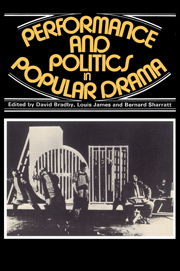 Performance and Politics in Popular Drama
Performance and Politics in Popular Drama Book contents
- Frontmatter
- Contents
- List of contributors
- Preface
- Acknowledgements
- PART ONE Spectacle, performance and audience in nineteenth-century theatre
- Introduction
- Was Jerrold's Black Ey'd Susan more popular than Wordsworth's Lucy?
- Word and image in Pixérécourt's melodramas: the dramaturgy of the strip-cartoon
- Joseph Bouchardy: a melodramatist and his public
- The music of melodrama
- Popular theatre in Victorian Birmingham
- Water drama
- Equestrian drama and the circus
- Theatre of war: the Crimea on the London stage 1854–5
- Popular drama and the mummers' play
- PART TWO Politics and performance in twentieth-century drama and film
- PART THREE Problems and prospects
- Appendix: Tempo, Tempo
- Select bibliography
- General index
- Index of titles of plays, films, sketches
- Index of theatres, theatre companies and groups
Water drama
Published online by Cambridge University Press: 08 March 2010
- Frontmatter
- Contents
- List of contributors
- Preface
- Acknowledgements
- PART ONE Spectacle, performance and audience in nineteenth-century theatre
- Introduction
- Was Jerrold's Black Ey'd Susan more popular than Wordsworth's Lucy?
- Word and image in Pixérécourt's melodramas: the dramaturgy of the strip-cartoon
- Joseph Bouchardy: a melodramatist and his public
- The music of melodrama
- Popular theatre in Victorian Birmingham
- Water drama
- Equestrian drama and the circus
- Theatre of war: the Crimea on the London stage 1854–5
- Popular drama and the mummers' play
- PART TWO Politics and performance in twentieth-century drama and film
- PART THREE Problems and prospects
- Appendix: Tempo, Tempo
- Select bibliography
- General index
- Index of titles of plays, films, sketches
- Index of theatres, theatre companies and groups
Summary
The history of the association of water with the drama is as old as the recorded history of the drama itself. During the century leading up to 1200 BC the Egyptian drama known as The Triumph of Horus was performed on, in, and around the sacred lake within the temple precincts of Edfu. Romans enjoyed the sea-battle entertainment known as the ‘Naumachia’, for which special flooded arenas were built. In the religious plays of the late middle ages real water occasionally makes its appearance, as in the moat surrounding the playing-place of The Castell of Perseverance, and in the Valenciennes passion play of 1547 which has its own ‘sea’, used for a variety of episodes. Allegorical water-shows became a part of the royal and civic revels of the renaissance. In England, these included the Earl of Leicester's shows for Queen Elizabeth on the water at Kenilworth as part of the ‘Princely Pleasures’ of 1575, and the entertainments offered to the Queen by the Earl of Hertford at Elvetham in 1591 on a specially excavated lake, as well as London Lord Mayor's Shows in which George Peele led the way in 1591 for much subsequent waterpageantry with the first Lord Mayor's Show on record that contains a speech delivered from a stage afloat on the Thames.
With the restoration of the monarchy in 1660 came the development of scenery and illusion in the public theatres in England. The use of water on stage in the form of hydraulic effects became fashionable. A theatrical fountain spouts as early as 1665, if we may go by Dryden's stage directions for The Indian Emperor.
- Type
- Chapter
- Information
- Performance and Politics in Popular DramaAspects of Popular Entertainment in Theatre, Film and Television, 1800–1976, pp. 91 - 108Publisher: Cambridge University PressPrint publication year: 1980
- 3
- Cited by


